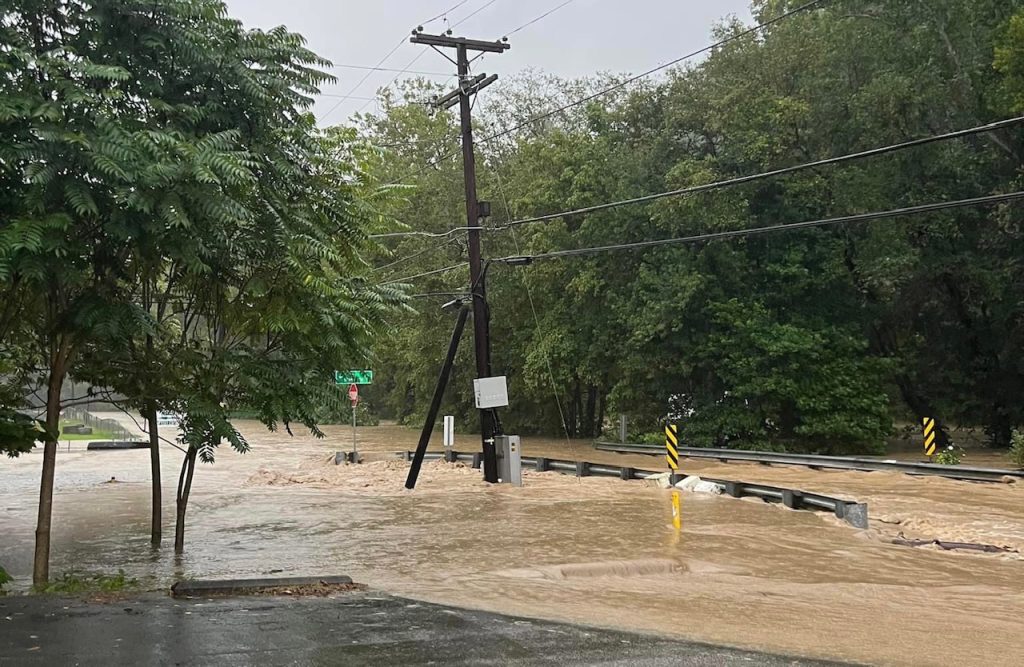Updated on Monday, Aug. 28, 2023 at 6:30 p.m.
Flooding throughout the day caused significant damage to roads, houses and bridges in central and southern West Virginia.
There have been no deaths reported so far due to flooding. Officials are still working to assess damage. Many houses were flooded and some were washed away.
Communities along Witcher Creek, Slaughter Creek and Fields Creek saw some of the most significant flooding. Waters have retreated back to creeks and rivers — where flows remain dangerously high. However, with more rain likely this evening and tomorrow, flood advisories remain active.
The National Weather Service said another inch of rain could be on the way Monday night.
Kanawha County Commissioner Lance Wheeler was at the Emergency Operations Center at Kanawha County Metro 911. He said fire departments in Charleston and Fayette and Cabell counties are waiting to see what the weather does, and where the water goes.
“Everybody’s still on standby. They are looking at what water is coming and what it’s going to look like and if there are going to be more evacuations necessary,” said Wheeler.
Wheeler said this amount of rainfall — 6-9 inches in affected areas — coupled with already saturated soil from a rainy weekend made the floods an especially dangerous situation.
“So, the flooding has been enormous at this point,” he said. “If there’s anyone out there who thinks that this is just a small flood that hit this area, they’re drastically wrong.”
Kanawha County officials say that from 6:45 a.m., when the Kanawha County Metro 911 started receiving calls, until 4 p.m., there were more than 700 calls and 22 water rescues. Assessors have not released official numbers, but Wheeler said that around 60 homes were washed away in the floods.
Jenna Sigmon lives along one of the most heavily flooded creeks, Slaughter Creek, and said she is used to floods, but this one is one of the worst she has ever seen.
“It was like kind of crazy, because we just woke up this morning and there was massive floods,” she said. “And the water came up over the bank all into our yard.”
Her house was flooded. Sigmon went over to a neighbor’s house across the road to get away from the water, but the water ended up crossing the street over to that house as well.
“It just kept rising and rising. Like two feet within ten minutes,” said Sigmon.
The water did eventually recede, but her yard and others around were bogged with water. She said she was expecting a flood, but not one this bad.
If you or anyone you know needs assistance escaping flooding, call 911 or (304) 348–8111 to reach the Metro 911 Emergency flood line.
Original Post: Flash Flood Emergency Declared In Several W.Va. Counties
The National Weather Service Monday issued a flash flood emergency for Kanawha County that is considered life threatening. It also issued flash flood warnings for parts of Braxton, Calhoun, Clay, and Roane counties. The National Weather Service says residents should seek higher ground and avoid flooded areas.
Gov. Jim Justice declared a State of Emergency in those counties. Heavy rainfall over the weekend and throughout Monday morning has caused flash floods that have damaged homes, roads, and bridges in affected areas. There are reports of high water along Witcher Creek in eastern Kanawha County.
The West Virginia Emergency Management Division has implemented an emergency plan to mobilize appropriate personnel and resources to respond to the emergency.
The National Guard is working to prepare for emergency dispatch with arial assets like helicopters, swift water rescues teams, and extra personnel. Kanawha County’s Emergency Operations Center is actively working to assist with water rescues and other emergency assistance.
The West Virginia Division of Highways is working to assist residents and clear the road from culverts, mudslides, and other damage from heavy rains throughout affected counties. Mudslides closed both lanes of US 60 in Belle and on the West Virginia Turnpike near Chelyan at Mile Marker 85.5 where the southbound right lane is closed.
FEMA, local officials, and other organizations are also working to offer aid to residents needing assistance.
